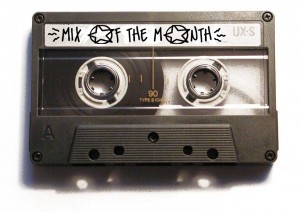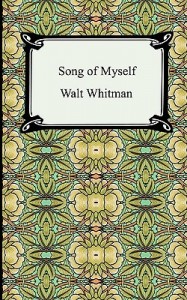Songs of Myself (Part 1)
By Asher Crispe: June 17, 2014: Category Inspirations, Simple Rhythms
 The poet Walt Whitman is remembered for extolling the ‘Song of Myself.’ Might musicality be at the very core of our identity? Does a melody offer up the best description of who I am? Do I have a song—THE song—which says it all or do I get a whole playlist? Those of us old enough to remember the now obsolete media of the music cassette, might still kindle warm feelings for the ‘mix-tape’ which we might have made for friends and loved ones. These were the songs that captured the feeling of the times, youthful emotions, travel, late night conversations, disappointments and heartache, yearning and ecstasy. Whatever one’s aptitude for finding the right words–for conventional communication–the music would somehow say more. It could be a prosthetic or an enhancement.
The poet Walt Whitman is remembered for extolling the ‘Song of Myself.’ Might musicality be at the very core of our identity? Does a melody offer up the best description of who I am? Do I have a song—THE song—which says it all or do I get a whole playlist? Those of us old enough to remember the now obsolete media of the music cassette, might still kindle warm feelings for the ‘mix-tape’ which we might have made for friends and loved ones. These were the songs that captured the feeling of the times, youthful emotions, travel, late night conversations, disappointments and heartache, yearning and ecstasy. Whatever one’s aptitude for finding the right words–for conventional communication–the music would somehow say more. It could be a prosthetic or an enhancement.
Selecting the songs that distill my sense of who I am at the moment does more than disclose some hitherto hidden part of my personality. In all honestly I change the music that I offer to others at any given time, not just on account of it reflecting my current emotions and thinking, but also because it transforms me. Sounds storm into the inner chambers of my unconscious and awaken something. Brought forth without a fully cut definition, the Self is enveloped and projected in the music.
One of the most beautiful teachings of the inner dimensions of the Torah is that each and everyone of us has a unique song that is the rhythmic vibration of our soul. This song is said to unlock the true nature of our identity and give us the ability to express all of our innate talents in this world. Certain pivotal figures throughout Jewish history that have taught the secret of how to unlock the properties of this soul melody which is the principle song of oneself. One such teaching comes from Rebbe Nachman of Breslov who taught that the notes that compose the song of each and every one of us are the nikudot tovot or ‘good points’ in our personality. We are our own musical composition.
If we are to look at the sense of music altogether from a mystical perspective, we would first have to go to one of the great classic works of Kabbalah—Sefer Yetzirah or The Book of Formation which puts forth a spectrum of sensory experience that exceeds that of the five natural senses which are localized in the body. Instead, we are presented with a full array of 12 or even 13 senses. So you might ask, “what are these other senses?” Many have heard of or speculated about a 6th sense which would be a portal to the paranormal–but 13 senses seems excessive and strange. While they have names which do not immediately trigger an everyday association, the later strata of Chassidic commentaries manages to tease out their signification in familiar terms. For instance, everyone readily acknowledges a sense of direction, a sense of security, a sense of balance and a sense of humor, to name a few of them. And, yes, a musical sense makes the list too.
All of these senses correspond to the various months of the year. Not surprisingly humor connects with the Hebrew month of Adar which contains the holiday of Purim. Sivan—the Hebrew month of the Sinaitic revelation–corresponds to the sense of direction in as much as the Torah was revealed to give us guidance as we journey though life. Yet, all of these senses are primarily spiritual. Even the basic ones like vision and hearing ultimately mark our capacity for insight or comprehension. Moreover, in their most extended manner, they resonate across the intellectual, emotional and behavioral spheres.
Now for a lesson in set theory: we are taught in Kabbalah that whenever we have a set of anything in the Torah, there will always be an all-inclusive unit which represents the set as a whole. The classic example is with the counting of the Omer period from the holiday of Passover to the giving of the Torah 50 days later on Shavuot. In this case we have a set of 49 days (themselves configured as 7 times 7, or 7 weeks with 7 days each) plus one, the 50th day, as the culmination of the entire process.
This is also the case with the set of the senses which number 12 with the 13th as the all-inclusive designation for amalgamation of the entire set. In fact, we can track and document many phenomena within the Torah that have this homologous relationship of 12 splitting into 13. Having already made mention of the parallels between the months and the senses, it is fitting that the months of a normal year are 12 in number but which jumps up to 13 every 2 to 3 years (7 times total in a 19 year cycle) when we fit in an extra month of Adar. Instead of having only one Adar (as is most commonly the case) the entire year is said to be ‘pregnant’ (ibur) with an additional month with slides in between the month of Shevat and the regular Adar (which explains why the Purim holiday is observed in the second Adar while the new Adar, now called the first [rishon] only has an echo of Purim with an informal, ‘small’ or diminished sense of Purim [Purim katan]). Consequently, there is a month which is both a particular month (one of 13) and a collective month (comprised of aspects of all the other 12). If one imagines an anthropomorphized year, then the 12 month are its natural body. However, when that temporal body is ‘pregnant,’ it builds the extra Adar out of the totality of itself just as the maternal lends from the whole of her material towards the formation of the fetus.
What, then, is the ‘pregnant’ month and what might we think about its correspondingly ‘pregnant sense? Of all the senses, the most all inclusive is the 13th sense which relates to music (nigun) and aligns with the extra month of Adar. All the senses are ‘expectant’ of music. Their mellifluous nature is born of the fusion of the set. Music, in its own way, turns into the ultimate hybrid sensory fruit.
Additionally, we may trace back this same configuration to the division of the Tribes of Israel. Generally depicted as a set of 12, they too break into 13 once Yosef (Joseph) is replaced with his two offspring Menashe and Ephraim. Even after this further division takes place, the Torah allocates 12 of the Tribes a specific part of the land of Israel while the exception befalls the Tribe of Levi who may occupy a portion of all of the other 12 Tribes. We get a reiteration of the idea of the particular standing both for itself and for the whole. The Levites remain their own tribe even as they participate in everyone else’s share in the land.
 Functionally, the tribe of Levi provided the musical accompaniment in the Temple, a role which hammers home this notion of their exemplifying the sense of music overall. Architecturally, the Temple (Beit HaMikdash) amplifies all of the spiritual dynamics swarming in the soul. Midrashically speaking, our forging of the Sanctuary or Temple is affirmed by the Divine presence dwelling within us. Analogous to the Levities singing in the Temple, our own aptitude of music enhances our interfacing with the Divine. Both the contemplation and emotional work needed for bridging heaven and earth sails on at the beckoning of the melodious orchestrations of our improvements of self and society.
Functionally, the tribe of Levi provided the musical accompaniment in the Temple, a role which hammers home this notion of their exemplifying the sense of music overall. Architecturally, the Temple (Beit HaMikdash) amplifies all of the spiritual dynamics swarming in the soul. Midrashically speaking, our forging of the Sanctuary or Temple is affirmed by the Divine presence dwelling within us. Analogous to the Levities singing in the Temple, our own aptitude of music enhances our interfacing with the Divine. Both the contemplation and emotional work needed for bridging heaven and earth sails on at the beckoning of the melodious orchestrations of our improvements of self and society.
The gates or access points to the courtyard of the Temple were 13 altogether with the identical 12 plus 1 ‘all-inclusive gate’ arrangement. The isomorphism between the Tribes each having an entrance into this zone of spiritual intensity assigned a clear channel and typology to each one. But what of those who forgot or did not recognize which Tribe they belong to? Or those for whom a discrete mode of sensory self-expression was unclarified? For all these exceptions and indeed open to all, there was an ‘easy’ all access pass or sha’ar hakollel, an ‘all-inclusive gate’ which anyone from any of the 12 Tribes could walk through. This suggests that music is the ultimate opening to the spiritual interior, the true universal language of the soul that is woven out of all of its sensory modes.
In Part Two we will endeavor to nuance the difference between prelinguistic wordless music and language driven songs with words.
http://www.interinclusion.org/inspirations/songs-of-myself-part-2/
Songs of Myself (Part 1),













;)
;)
;)
;)
;)
;)
;)
;)
;)
;)
